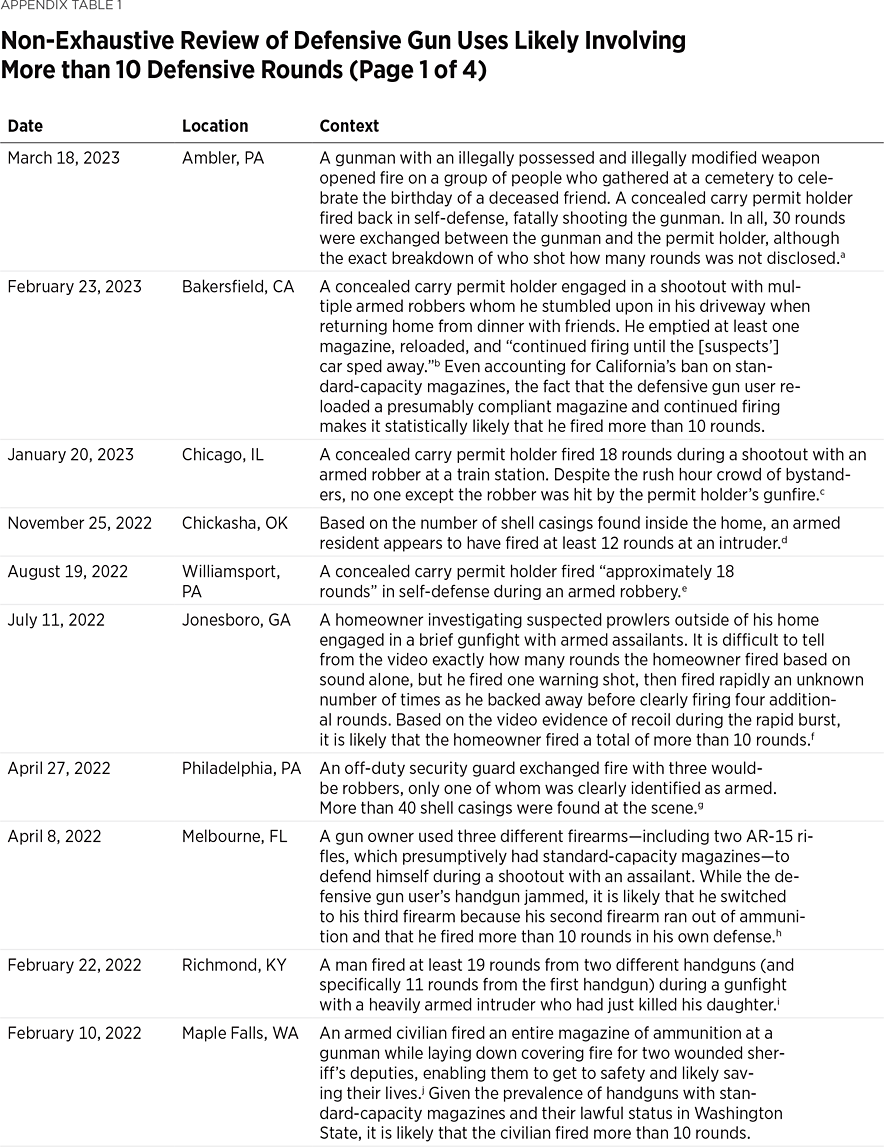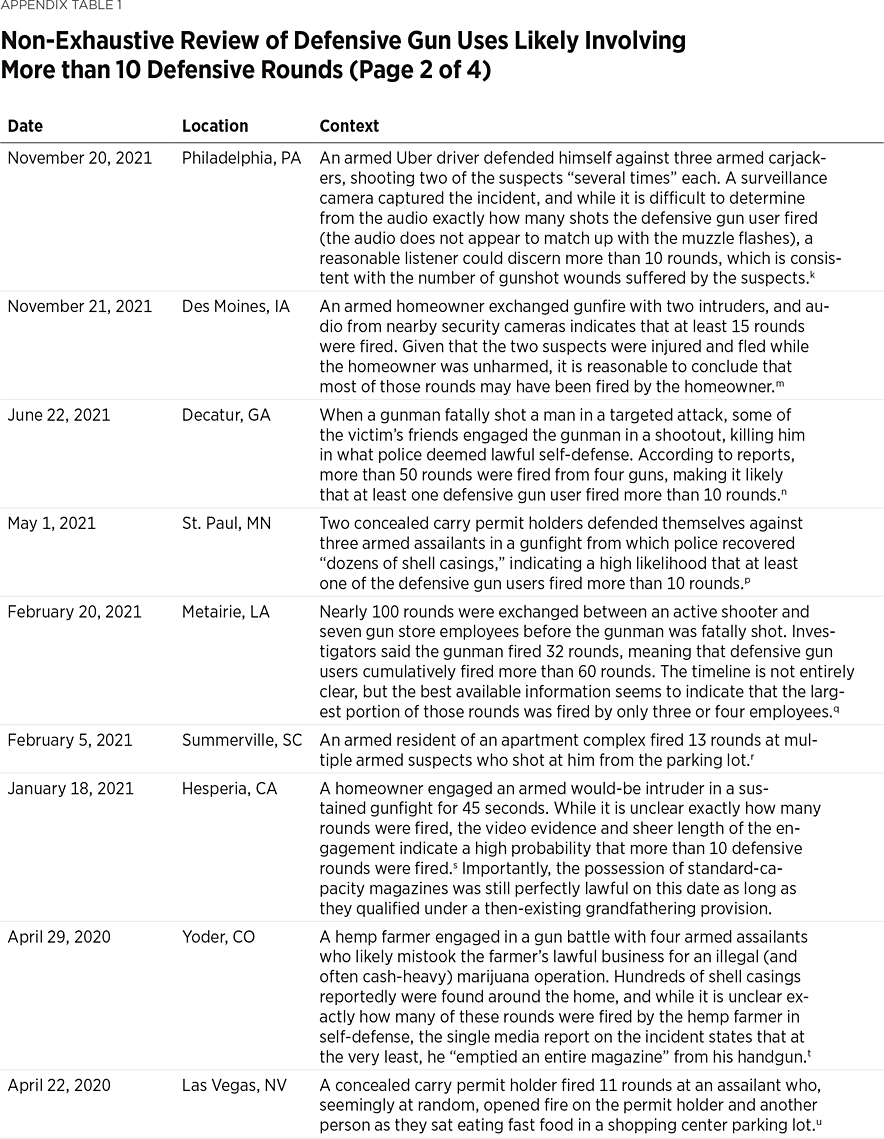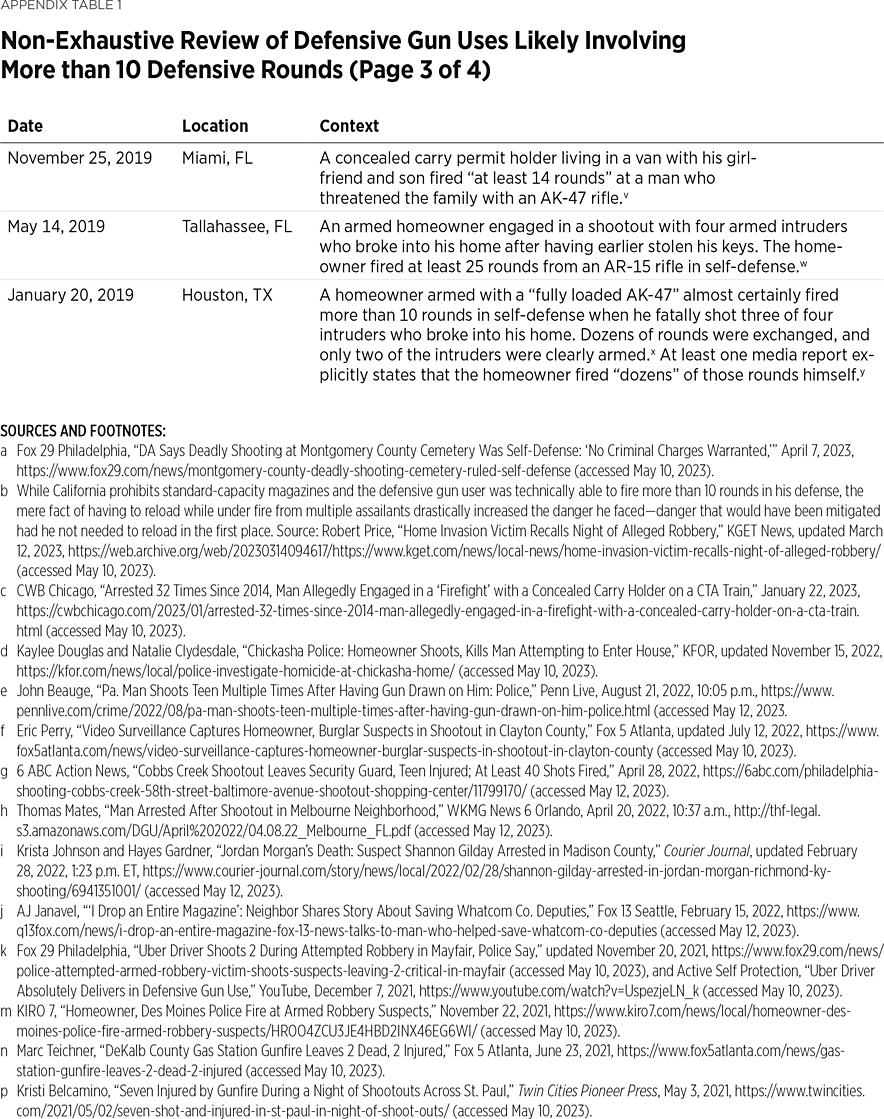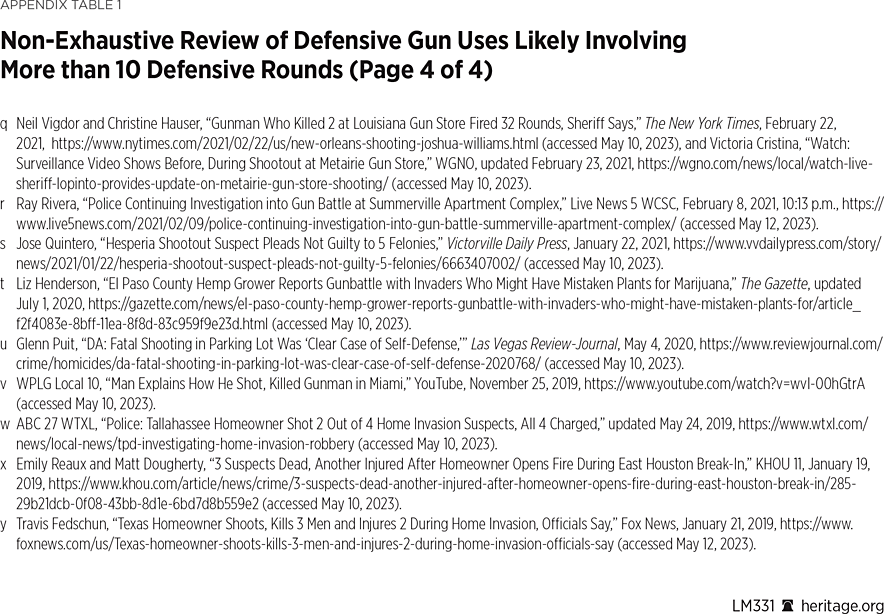In recent decades, gun control advocates have been fixated increasingly on passing laws that would prohibit the civilian possession of so-called large-capacity magazines. While the definition is entirely arbitrary and varies even across the handful of states in which they are regulated, “large-capacity” magazines are most often defined as magazines capable of holding more than 10 rounds of ammunition.REF
Gun control advocates routinely decry these devices as being used largely for criminal purposes, cynically questioning why law-abiding citizens would ever be in a situation requiring them to fire more than 10 rounds without reloading. In reality, magazines with a capacity of more than 10 rounds are the factory standard for many of the most popular guns on the civilian market and have been for more than a century. Countless Americans own them for precisely the same reasons that police departments commonly issue them to peace officers: While the circumstances in which they are strictly “necessary” for self-defense may not be everyday occurrences, their presence in those situations is important. Moreover, advocates of magazine capacity limits routinely overstate the potential public safety benefits of such laws and underestimate the myriad ways in which criminals can (and already do) circumvent them.
The willingness of gun control advocates to stretch the truth about magazine capacity recently reached new heights. On November 30, 2022, a conglomerate of gun control groups filed a brief of amici curiae before a federal district court in Hanson v. District of Columbia, a case in which the plaintiffs are challenging the District of Columbia’s “large-capacity” magazine ban for civilians.REF In this brief (hereinafter the Brady Brief), the gun control groups argued in part that the District’s limitation on magazine capacity for civilians is constitutionally sound because civilians simply do not need more than 10 rounds to defend themselves. To support this argument, the brief referenced two articles on defensive gun use published by The Daily Signal, the multi-media arm of The Heritage Foundation, as part of a monthly series dating back to 2019. Based on these two articles alone the brief argued that:
Even advocates of the permissive use of firearms have acknowledged that the ability to fire more than ten rounds of ammunition without reloading is not necessary for defensive purposes. For example, recent compilations by The Heritage Foundation’s The Daily Signal of national reports on defensive gun use cases reflect that none involved the use of anywhere close to ten rounds of ammunition.REF
At best, the Brady Brief’s characterization of these monthly articles on defensive gun use is recklessly lazy and wrongly attributes to the authors (and The Heritage Foundation more broadly) a policy position that neither holds. At worst, it constitutes an intentional effort to deceive a federal court with blatantly misleading claims about The Heritage Foundation’s research and scholarship on defensive gun uses and Second Amendment policy. Far from “acknowledging” that magazine capacity laws have no harmful impact on civilian self-defense, Heritage’s scholarship unambiguously supports the position that peaceable Americans have a constitutional right to possess magazines with a capacity of 11 or more rounds and that the possession of such magazines during a defensive gun use, as demonstrated below, can sometimes be the difference between life and death or serious bodily injury.
Magazine Capacity, the Constitution, and Public Policy
Irrespective of whatever information can be gleaned from Heritage’s Defensive Gun Use DatabaseREF on the importance or prevalence of standard-capacity magazines during civilian defensive gun uses, laws prohibiting their sale to (or possession by) law-abiding citizens suffer from a host of constitutional and public policy concerns. These concerns are nothing new and have been raised for many years by Second Amendment advocates both affiliated and unaffiliated with The Heritage Foundation.REF
From a purely constitutional perspective, the prevalence of defensive gun uses involving more than 10 rounds being fired is irrelevant to the question of whether the Second Amendment protects a right to possess magazines with a capacity of 11 or more rounds. The Supreme Court of the United States has not so far reviewed a challenge to laws limiting magazine capacity for civilians. This includes the 1994 Federal Assault Weapons Ban, which before it sunset without renewal in 2004 prohibited the sale of magazines holding 10 or more rounds to civilians.REF However, given the Court’s subsequent holdings in foundational Second Amendment cases like District of Columbia v. HellerREF and New York Rifle & Pistol Association v. Bruen,REF it is difficult to see how any court could uphold magazine capacity limits while remaining faithful to the existing jurisprudential framework.
In Heller, the Supreme Court affirmed that the Second Amendment protects an individual right to keep and bear arms centered on self-defense and struck down a District of Columbia law banning the civilian possession of operable handguns inside the home.REF In so doing, it reasoned that the Second Amendment’s protections are not limited only to those arms in existence at the time of ratification but “extend[], prima facie, to all instruments that constitute bearable arms.”REF While “dangerous and unusual” arms may fall outside of the Amendment’s scope, it certainly covers small arms (in this case, handguns) that are “typically possessed by law-abiding citizens for lawful purposes” like self-defense.REF The Court re-emphasized this “common lawful purpose” concept two years later in McDonald v. City of Chicago, in which it also determined that the Fourteenth Amendment’s Due Process Clause extended the Second Amendment’s protections against state infringement as well.REF Most recently, under Bruen, the Court explained that, to be constitutional, any challenge restriction on the right to keep and bear arms must be consistent with the nation’s historical tradition of firearms regulation.REF
However accurate they may be, the assertions by gun control advocates that law-abiding citizens rarely need to fire more than 10 rounds without reloading during a defensive gun use are premised on addressing the wrong question. The relevant question under Heller is not whether an arm is strictly or commonly necessary for purposes of self-defense, but whether it is commonly possessed by law-abiding citizens for lawful purposes. There can be little doubt that magazines are “arms” or at least so critical to the functioning of arms that they receive the same constitutional protections as the “arms” that require them. Guns require ammunition to function as intended, and many of the most commonly possessed firearms rely on magazines to feed ammunition into the chamber. Those magazines are therefore unquestionably necessary components for one to be able to exercise his or her right to keep and bear arms.
It is also unquestionably true that law-abiding Americans commonly own magazines capable of holding more than 10 rounds as well as firearms capable of accepting those magazines. Data collected by the 2021 National Firearms Survey, which is the most comprehensive survey of American gun owners ever conducted, suggest that nearly half of American gun owners have owned a magazine with a capacity of 11 or more rounds.REF Most of these approximately 39 million gun owners with standard-capacity magazines possess several of them, suggesting that more than 500 million such magazines may currently be in civilian circulation.REF The most common reasons that gun owners cite for possessing magazines that hold more than 10 rounds are recreational target shooting (64.3 percent); home defense (62.4 percent); hunting (47 percent); defense outside the home (41.7 percent); and competitive shooting sports (27.2 percent).REF All are traditionally considered to be lawful activities.
While the Second Amendment’s protections are not limited to the technology that existed in 1792, multi-shot firearms were well-known to the Founding generation.REF The trend in firearm manufacturing toward increased ammunition capacity was already well underway by the time the Second Amendment was ratified.REF Rifles with magazines capable of holding more than 10 rounds of ammunition first achieved mass-market success in the late 1860s, and handguns with such magazines first became popular in the 1930s.REF By the 1960s and 1970s, advancements in magazine technology had made magazines capable of holding more than 10 rounds the factory standard for many of the most popular firearms on the civilian market, and millions of such firearms were sold.REF
As one might guess from the long-standing popularity of larger-capacity magazines among civilians, attempts to limit magazine capacity for civilian gun owners are a modern phenomenon. Far from being rooted in some historical tradition of regulation, the first three laws even remotely resembling modern bans on large-capacity magazines did not arise until the 1930s—and two of the three were repealed within decades.REF Even today, limits on magazine capacity exist in only a minority of states, most of which did not impose those limitations until the 21st century.REF
Constitutional concerns aside, laws that restrict magazine capacity for civilians are just poor public policy. First, even if compliance is widespread and coupled with proactive enforcement, the potential benefits to public safety are limited at best. Suicides, not homicides, account for the bulk of annual gun deaths, and in such circumstances, magazine capacity is almost entirely irrelevant.REF Most gun crimes are not targeted shootings with an underlying intent to kill, but rather robberies and aggravated assaults in which the perpetrator brandishes—but does not fire—the gun.REF Even with respect to the minority of gun crimes in which perpetrators fire their weapons, it is not at all clear that magazine capacity limits offer meaningful benefits. Only a small percentage of homicides involve two or more victims, which are the types of crimes most likely to require an offender to fire more than 10 rounds to accomplish his or her criminal purpose.REF Moreover, the official analysis of the 1994 federal law prohibiting the sale of magazines with a capacity of more than 10 rounds concluded that there was “no evidence of reductions in multiple-victim gun homicides or multiple-gunshot wound victimizations” as a result of the prohibition.REF This is hardly surprising, given that the “banned…magazines were used in only a minority of gun crimes before the law.”REF
Importantly, there is no reason whatsoever to assume either that compliance with magazine capacity laws would be widespread or that the laws would be effectively and vigorously enforced. In fact, it appears that Americans are widely and openly noncompliant with laws prohibiting the possession of standard-capacity magazines in states that have already imposed them.REF If the mass of peaceable Americans are notoriously unwilling even to register “grandfathered” guns and magazines under less confiscatory frameworks, what reason is there to believe that the more criminally bent sectors of society would simply turn in their banned magazines and never again buy, steal, or 3D-print new ones?REF
It is little wonder, then, that proponents of magazine capacity limitations have increasingly turned away from arguments that these laws will lower crime rates generally and instead focus on their alleged impact on the least common type of gun violence: mass public shootings.REF One of the most popular arguments raised in favor of limiting magazine capacity for civilians is that standard-capacity magazines may enable mass public shooters to inflict higher numbers of casualties by decreasing the number of times they need to reload. Again, even assuming widespread compliance and effective enforcement, limiting magazine capacity is unlikely to lower casualty rates in mass public shootings to any meaningful degree.
First, mass public shooters can (and routinely do) work around these limitations by bringing several firearms and extra loaded magazines, easily replacing expended magazines within seconds.REF Moreover, analysis of data from mass public shootings shows that most perpetrators do not actually use magazines capable of holding more than 10 rounds and that, in any event, mass public shooters typically do not fire at a rate that is fast enough for casualty counts to be attributed to magazine capacity.REF This conclusion is supported by the findings of various panels analyzing the effect of magazine capacity for individual mass shootings as well as by the reality that high casualty counts have occurred during shootings where only “limited-capacity” magazines were used.REF
Finally, the reality is that mass public shooters throughout American history have been more than capable of killing large numbers of people even with far more “rustic” and “limited-capacity” guns than today’s modern rifles with “large-capacity” magazines. For example:
- In 1915, an aggrieved man armed with a double-barrel shotgun walked into a law office in downtown Brunswick, Georgia, and fatally shot a judge.REF He then continued shooting random people in the crowded business district, ultimately killing seven and wounding 30 in just 10 minutes, having apparently considered how to reload his firearm most efficiently and effectively for maximum carnage.REF He would in fact kill more people than a different aggrieved man who, more than a century later, walked into a downtown Louisville, Kentucky, bank with an “assault weapon” and “high-capacity” magazines and began indiscriminately shooting his colleagues.REF
- In 1949, a man with nothing more than a single 9mm pistol with an eight-round magazine killed 13 and wounded three more in just 12 minutes during a mass public shooting in Camden, New Jersey.REF His actions stopped not because of his “limited” magazine capacity, but because he simply ran out of bullets and surrendered.REF He would nonetheless kill and injure more people than would a gunman with “high-capacity magazines” at a Buffalo, New York, supermarket more than eight decades later.REF
These are far from the only examples of historical mass public shootings with high casualty counts that tend to disprove an assertion that such atrocities are a modern phenomenon or meaningfully facilitated by a gunman’s use of modern, standard-capacity magazines.REF
It is clear that laws limiting magazine capacity for civilians are both constitutionally problematic and unlikely to have a significant impact on public safety even if perfectly enforced. It is not just that these laws have little practical effect on criminal actions—they would at the same time undermine the practical ability of peaceable citizens to defend themselves in those scenarios where the need for armed self-defense is most acute, such as when they are outnumbered, outgunned, or otherwise placed at a tactical disadvantage.
These scenarios of tactical disadvantage are almost certainly more common for peaceable citizens than for criminals, who have the upper hand in planning and executing their crimes. Unlike law-abiding citizens, who must reactively defend themselves whenever and under whatever circumstances they are victimized, criminals can (and often do) wait for (or even create) the most advantageous circumstances. For example, a significant percentage of homicides, robberies, and other violent crimes involve multiple offenders.REF Multiple-offender homicides in particular are becoming increasingly common: In 2008, roughly one of every five homicides involved multiple offenders.REF
Gun control advocates arguably concede this point on the potential importance of being able to fire more than 10 rounds without reloading when they support magazine capacity laws that universally exempt law enforcement officers, often including in their off-duty capacities and with their personal firearms.REF Law enforcement officers in the United States are peace officers acting in a civilian context and generally speaking respond to the same criminal threats first faced by the peaceable citizens who called them for assistance in the first place. The circumstances under which they may use deadly force largely parallel the laws of self-defense for civilians. While off duty, their powers of arrest and investigation in many cases are based solely on the rights of citizens’ arrest possessed by all other members of society. And while most civilian defensive gun uses do not involve any rounds being fired, much less more than 10 rounds being fired, the same is true of police-involved shootings.REF To whatever extent, then, that standard-capacity magazines are useful for law enforcement officers, they are equally useful for civilians who face those same threats.
What Heritage Defensive Gun Use Database Actually Shows About Magazine Capacity in Defensive Shootings
What, then, do the Heritage Defensive Gun Use Database and corresponding monthly Daily Signal series actually show about the importance of standard-capacity magazines for civilian defensive gun use? While such cases likely do not constitute a majority of defensive gun uses, either by civilians or by law enforcement officers, in those cases where more than 10 rounds are needed, the ability to fire those rounds without the need to reload can be the difference between life and death or serious bodily injury. Those cases often involve a defensive gun user who is outnumbered by multiple armed assailants or who is engaged in a sustained gun battle with an assailant who is heavily armed.
Incidents of civilian defensive gun use are inherently difficult to analyze, and it would be impossible to determine the exact number that occur every year, much less to gauge the exact number that involve the firing of more than 10 defensive rounds. It is clear, however, that civilian defensive gun uses are common occurrences. Studies consistently conclude that in any given year, Americans use their guns defensively between 500,000 and several million times, with the best available evidence indicating that the real average is probably somewhere between 1 million and 2 million times a year.REF Most of these defensive gun uses do not involve a gun being fired, will not receive the slightest bit of media attention, and may not even be reported to police.REF In general, media reports on a defensive gun use rarely include specific information on the number of rounds fired by either the offender or the defensive gun user. Sometimes, contextual information—like the number of gunshot wounds sustained by an offender—can provide insight into a potential minimum number of defensive rounds fired, but not an upper limit.
The Heritage Defensive Gun Use Database was not designed to track specific case features like the number of rounds fired defensively and does not purport to maintain an exhaustive record of cases in which more than 10 defensive rounds were fired. Moreover, the monthly article series published by The Daily Signal does not provide an exhaustive list of defensive gun use cases compiled in the database in any given month. As the articles themselves clearly explain, the series covers at most only a fraction of the media-verified cases compiled in any given month and is intended to be more of a highlight reel than a comprehensive resource. Cases for these monthly articles are chosen to a large extent based on aesthetic factors like ensuring that featured cases are somewhat evenly spaced throughout a given month and maintain a reasonable amount of both geographic and contextual diversity.
It is in no way reasonable to conclude, as the Brady Brief does, that if one of the monthly Daily Signal articles does not include an example in which a defensive gun user fired more than 10 rounds, then no such cases occurred. Ironically, the September 2022 article cited by the Brady Brief illustrates this point perfectly.REF Missing from that article (which covers cases from August 2022) is an August 19, 2022, defensive gun use in Williamsport, Pennsylvania, by a concealed carry permit holder who fired “approximately 18 rounds” at an armed robber.REF This defensive gun use was not highlighted in the monthly roundup, but it was included in The Heritage Foundation’s interactive database and featured on the database’s official Twitter account.REF
Even a cursory review of the more than 3,000 media-verified defensive gun uses compiled in the database shows that the Williamsport case is far from the only instance involving a defensive gun user who clearly fired more than 10 rounds that was not featured in the monthly highlight article. For example, the March 2022 article did not cover a February 22, 2022, defensive gun use that occurred in Richmond, Kentucky, in which a man fired at least 19 rounds during a shootout with an intruder who had just killed his daughter.REF Nor did the March 2021 article feature a February 5, 2021, case in Summerville, South Carolina, in which an armed resident fired 13 rounds at multiple armed assailants who shot at him from his apartment complex’s parking lot.REF
The authors of the Brady Brief also apparently assume that if a media report (or a summary of the media report featured in the monthly Daily Signal highlight article) does not explicitly state that a defensive gun user fired more than 10 rounds, then it could not have occurred. True, it is sometimes evident from the broader context that fewer than 10 rounds were fired or at least that such an event was unlikely. Other times, however, this assumption is entirely unwarranted. This includes two cases featured in the articles cited by the Brady Brief and far too easily dismissed as involving “nowhere close” to the firing of 10 rounds in self-defense.
- In the August 16, 2022, case in Lexington, South Carolina, that was featured in the cited September 2022 Daily Signal article, both the assailant and the defensive gun user sustained multiple gunshot wounds during an exchange of gunfire inside the defensive gun user’s home.REF As far as can currently be discerned, law enforcement officers did not release details to the public concerning the number of rounds fired during the shootout. The broader context of this defensive gun use, however, is one in which it is certainly plausible that the defensive gun user fired more than 10 rounds. Much like the defensive gun user in the Richmond, Kentucky, case mentioned above, the defensive gun user here was involved in what appears to have been an intense gun battle with a heavily armed opponent in which both parties would have had ample opportunity for defensive cover.
- Similarly, a June 16 incident in Hopkinsville, Kentucky, that was featured in the July 2022 article cited by the Brady Brief includes language and circumstances making it entirely plausible for the defensive gun user to have fired more than 10 rounds. That elderly homeowner was involved in a shootout with three armed intruders who fired at him first, and the most detailed articles available say merely that the homeowner “returned shots.”REF Unless the authors of the gun control brief have information to which the original journalists were not privy, there is no reasonable basis for concluding that the homeowner could not have fired or in fact did not fire more than 10 rounds in self-defense in a gunfight with multiple assailants.
This type of scenario, like any other scenario in which it is almost certain that the defensive gun user fired more than 10 rounds, is so commonly featured in the monthly articles that the authors of the Brady Brief must have gone out of their way to ignore any articles that did not fit the misleading narrative they wished to convey. For example:
- The May 2022 highlight article featured a Florida gun owner who used three different firearms to defend himself during an April shootout.REF While his first firearm appears to have jammed, it is reasonable to assume that he moved to his third firearm because he expended all of the ammunition in his second firearm—an AR-15 rifle that commonly utilizes 30-round magazines. The odds are therefore very high that this defensive gun user cumulatively fired more than 10 rounds from those three firearms.
- During a September 2022 defensive gun use from Chicago featured in the October 2022 highlight article, a concealed carry permit holder in Chicago shot back at gunmen who opened fire on a birthday celebration.REF Although reports do not say for certain how many rounds were fired by either the gunmen or the defensive gun user, so many were fired in total that one witness described initially thinking that the gunshots were fireworks.REF
As with cases explicitly involving more than 10 rounds fired in self-defense, the monthly articles have also omitted plenty of cases from the database in which it was statistically probable that the defensive gun users fired more than 10 rounds. For example:
- In February 2022, a civilian gun owner in Maple Falls, Washington, fired an entire magazine’s worth of ammunition at a gunman while providing covering fire for two wounded sheriff’s deputies who were pinned down, allowing them to move to safety and likely saving their lives.REF While the few readily available media reports on this shootout do not appear to include any information on the defensive gun user’s magazine capacity, both the prevalence of semi-automatic handguns that use magazines capable of holding more than 10 rounds and the lawful nature of their possession in Washington State make it entirely unreasonable to conclude that the defensive gun user could not have fired or did not in fact fire more than 10 rounds.
- A July 2022 Philadelphia, Pennsylvania, case involved at least 40 rounds fired between the victim and his three assailants, only one of whom was clearly portrayed in media reports as being armed.REF It is statistically reasonable, if not highly probable, for the victim to have fired more than 10 of those rounds under the circumstances.
Finally, the monthly articles sometimes include summaries of defensive gun uses that unintentionally omit relevant information on the number of rounds fired in self-defense. This happened, for example, in the very first article of the series, which was published in January 2019. The summary for a January 20 incident simply noted that a homeowner killed three of four intruders but, likely for purposes of brevity, left out the detail that he fired dozens of rounds during that gun battle.REF Similarly, the December 2021 article featured a November 20, 2021, shooting in Philadelphia in which an Uber driver shot and wounded two of three armed robbers, but did not note that video of the shootout indicates that he probably fired more than 10 rounds.REF
As the primary purpose of this monthly article series never has been to compile and showcase every single time a defensive gun user fires more than 10 rounds, it is likely that other articles in this series also contain case summaries inadvertently glossing over such information.
Along those same lines, neither the Daily Signal article series nor the Defensive Gun Use Database provides insight into the number of times defensive gun uses prove unsuccessful—or are rendered significantly less successful—precisely because a gun owner is killed or sustains serious injury because he or she was limited to fewer than 10 rounds. Such cases would be as difficult to research using available media reports as are cases involving more than 10 rounds fired defensively, but they do clearly occur and would be equally relevant to the policy conversation.
As just one example, during a May 2022 incident in Haines City, Florida, a defensive gun user was fatally shot while reloading his firearm during a gunfight with his assailant.REF The victim’s firearm was a revolver, a type of gun that almost always has a capacity of less than 10 rounds.REF And, of course, there are cases that predate the current scope of the Defensive Gun Use Database, which currently includes only cases that occurred on or after January 1, 2019.REF
Conclusion
Any assertion that The Heritage Foundation’s scholarship on defensive gun use implicitly supports magazine capacity limitations for civilians should be categorically rejected. On the contrary, it shows that bans on the civilian possession of standard-capacity magazines threaten to have devastating effects on law-abiding gun owners who find themselves outnumbered, outgunned, or otherwise at a disadvantage against criminal actors. It is neither constitutional nor prudent for the government to tie one hand behind the backs of peaceable gun owners, especially when it exempts itself from that same prohibition in a tacit acknowledgement that standard-capacity magazines can be incredibly useful and necessary tools when facing criminal threats in a civilian context.
Amy E. Swearer is a Senior Legal Fellow in the Edwin Meese III Center for Legal and Judicial Studies at The Heritage Foundation.







